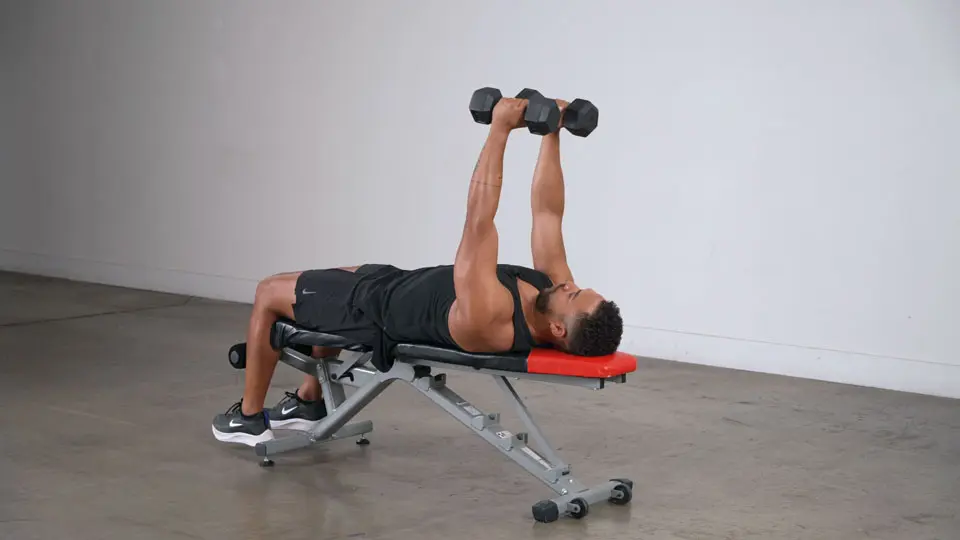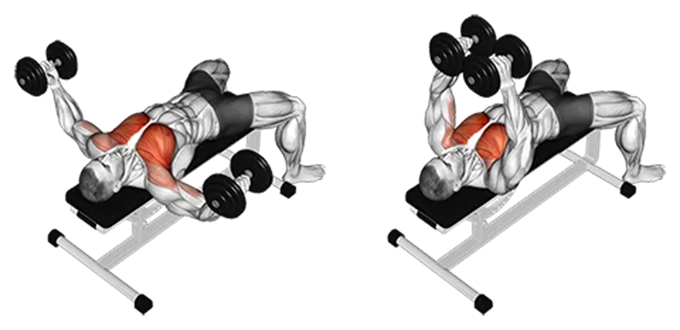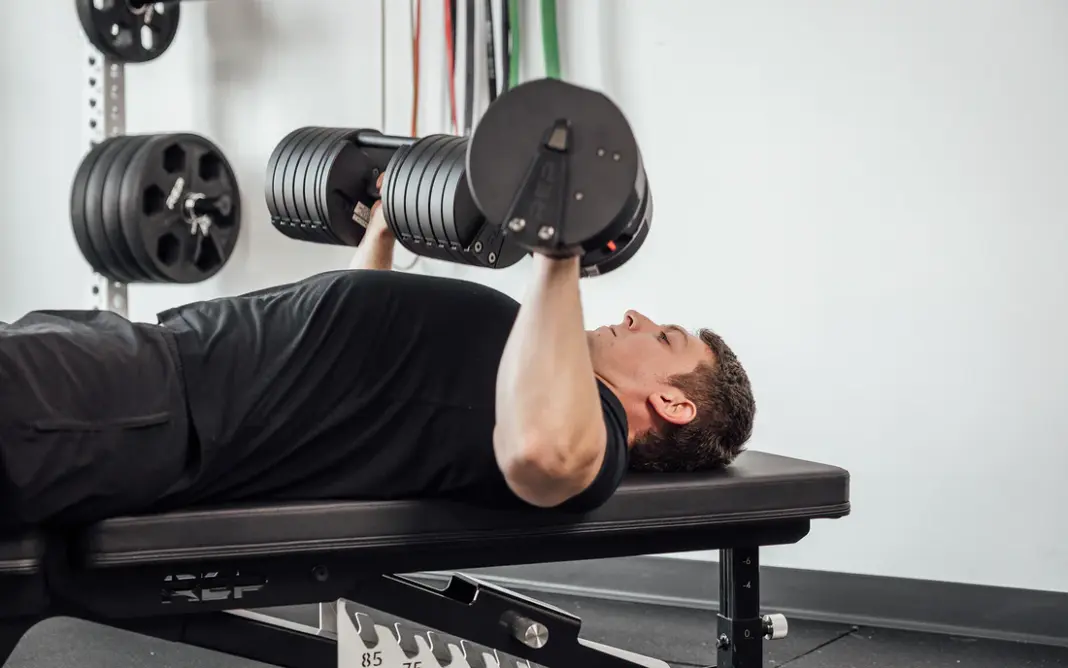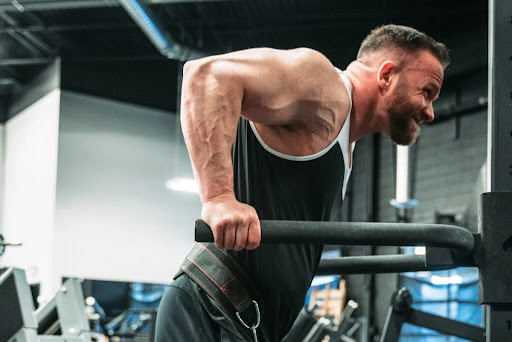Flat Dumbbell Fly: The Ultimate Chest Isolation & Stretch Exercise
The Flat Dumbbell Fly is one of the most iconic movements in chest training — a pure isolation exercise that targets the pectoralis major through a deep stretch and intense contraction.
While presses build strength and density, the fly refines shape, separation, and definition, emphasizing the stretch and squeeze phases that stimulate the chest’s inner and outer fibers.
In bodybuilding terms, it’s the “finishing” exercise that gives the pecs their rounded, sculpted appearance. When performed correctly, the flat fly delivers unmatched tension and muscle fiber elongation, unlocking new growth potential and helping you connect deeply with your chest on every rep.
Muscles Worked
- Primary Muscle:
- Pectoralis Major (Sternal Head — Mid-Chest Focus)
- Secondary Muscles:
- Anterior Deltoids
- Biceps Brachii (as stabilizers)
- Serratus Anterior
- Core (for stabilization on the bench)
The Flat Dumbbell Fly isolates the chest far more than compound presses. The triceps play a minimal role here — your chest is forced to do nearly all the work through the horizontal adduction motion.
Why the Flat Dumbbell Fly Works
- Peak Stretch Activation:
The fly allows the pecs to reach a maximum stretched position, stimulating muscle fibers deep near their attachment points. - Full Contraction Potential:
By bringing the arms together across the chest, you engage both the inner and outer chest through their full contractile range. - Improved Mind–Muscle Connection:
Because the load is lighter and more controlled, you can focus on feeling the pecs work — perfect for advanced hypertrophy. - Joint-Friendly Isolation:
When done with proper form, it minimizes shoulder and elbow strain while enhancing pec mobility and flexibility. - Aesthetic Refinement:
Great for defining separation lines between the pectorals and deltoids, creating that sharp, sculpted look prized by physique athletes.
Setup
- Equipment:
- Flat bench
- Pair of light-to-moderate dumbbells
- Body Position:
- Sit on the bench holding dumbbells on your thighs.
- Lie back while using your knees to help lift the dumbbells into position above your chest.
- Grip & Arm Position:
- Palms facing each other (neutral grip).
- Slight bend in elbows — about 10–15 degrees — and keep that angle locked throughout the movement.
- Shoulder Position:
- Retract and depress your shoulder blades (“pin them down and back”).
- Keep your chest elevated to maximize pec tension.
- Starting Point:
- Dumbbells together above your chest, arms extended (slight elbow bend).
- Feet planted firmly on the floor.
How to Perform the Flat Dumbbell Fly
Step-by-Step Execution
- Begin the Descent (Stretch Phase):
- Inhale and slowly lower the dumbbells outward in a wide arc.
- Keep the same bend in your elbows — don’t let them flare open.
- Focus on stretching the chest, not lowering the weight with your arms.
- Lower until your chest feels a deep stretch — dumbbells should reach about chest level or slightly below.
- Squeeze the Contraction (Lift Phase):
- Exhale and bring the dumbbells back up in the same wide arc, leading with your elbows, not your hands.
- Stop when the dumbbells are directly above your chest (not touching).
- Focus on squeezing your pecs together at the top — visualize pressing your upper arms inward across your body.
- Peak Contraction:
- Hold for 1 second at the top, maintaining full chest tension.
- Controlled Lowering:
- Slowly lower back into the stretch position.
- Maintain full control throughout — never drop or swing the weights.
Form Cues
✅ “Imagine hugging a big tree — your arms move in a semi-circle.”
✅ “Keep your elbows soft and locked; don’t bend or straighten during the movement.”
✅ “Pull your shoulder blades together and down into the bench.”
✅ “Focus on pulling the dumbbells together using your chest, not your arms.”
✅ “Control the eccentric — the stretch is where the magic happens.”
✅ “Keep tension constant; don’t rest at the top.”
Programming Strategies
- Hypertrophy & Isolation Focus
Designed for maximum chest engagement and stretch.
- Sets/Reps: 3–4 sets of 10–15 reps
- Rest: 60–90 seconds
- Tempo: 3–4 seconds down, 1 second up
- Goal: Maximize stretch and contraction — prioritize tension over weight.
- Finisher or Pump Work
Used at the end of a workout to flood the chest with blood.
- Sets/Reps: 2–3 sets of 15–20 reps
- Rest: 45–60 seconds
- Goal: Focus on feel, not load — maintain constant pec tension.
- Pre-Exhaust Method
Use flies before compound presses to pre-fatigue the pecs.
- Example:
- Flat Dumbbell Fly – 3×12–15
- Flat Barbell or Dumbbell Press – 4×8–10
- Goal: Ensure the chest hits failure before triceps or shoulders.
Variations
- Cable Fly (Flat or Standing)
- Maintains constant tension throughout the range.
- Great for continuous resistance and chest contraction control.
- Machine Chest Fly
- Offers fixed motion and stability.
- Ideal for beginners or those rehabbing shoulder injuries.
- Stability Ball Dumbbell Fly
- Increases core engagement.
- Demands more balance and shoulder control.
- Alternating Dumbbell Fly
- Perform one side at a time.
- Extends time under tension and improves unilateral balance.
- 1½ Rep Fly
- Lower fully → halfway up → back down → full rep up.
- Brutal on chest fibers, excellent for hypertrophy plateaus.
Common Mistakes & Fixes
❌ 1. Turning It into a Press
- Bending elbows too much turns the movement into a press, reducing chest isolation.
✅ Fix: Keep elbows slightly bent but fixed throughout.
❌ 2. Dropping Dumbbells Too Low
- Overstretching can stress shoulder joints.
✅ Fix: Lower only until a deep chest stretch is felt — not shoulder strain.
❌ 3. Using Momentum
- Swinging the dumbbells removes tension from the chest.
✅ Fix: Slow down the eccentric; stay controlled.
❌ 4. Letting Dumbbells Touch at the Top
- Relieves chest tension prematurely.
✅ Fix: Stop just short of touching — maintain constant engagement.
❌ 5. Losing Shoulder Stability
- Lifting with shoulder rotation instead of pecs can lead to injury.
✅ Fix: Keep shoulder blades retracted and pressed firmly into the bench.
Advanced Training Techniques
- Drop Sets
- Start heavy, go to failure, immediately reduce weight and continue.
- Increases metabolic stress and total volume.
- Slow Eccentrics
- 4–5 seconds lowering phase per rep.
- Builds muscle through controlled tension and stretch.
- Superset with Press
- Pair Fly → Dumbbell Press.
- Combines isolation and compound overload for full fiber recruitment.
- Isometric Hold Fly
- Pause for 2–3 seconds at peak contraction.
- Forces sustained pec tension, improving mind–muscle connection.
- Partial Fly Reps (Bottom Range)
- Stay in the stretch zone (bottom half).
- Excellent for fiber stretch and hypertrophic stress.
Mind–Muscle Connection Tips
- Visualize bringing your upper arms together, not your hands.
- Keep your pecs flexed throughout the full range.
- Focus on the deep stretch and the controlled inward squeeze.
- At the top, pause and contract the inner chest — that’s where the fibers peak.
- Don’t rush — slower reps equal better control and recruitment.
Programming Example: Mid-Chest Hypertrophy Focus
Workout Example:
- Flat Barbell Bench Press – 4×6–8
- Flat Dumbbell Press – 3×8–10
- Flat Dumbbell Fly – 3×12–15
- Low-to-High Cable Fly – 3×15–20
- Push-Up (Weighted or Standard) – 2×Failure
This sequence hits the mid-chest from all angles — compound overload, isolation stretch, and pump work.
Bodybuilder’s Insight
Legendary bodybuilders like Arnold Schwarzenegger and Frank Zane considered the flat dumbbell fly a foundational “shaping” exercise — not for mass alone, but for refining the chest’s roundness and detail.
Arnold often described it as “hugging a barrel,” emphasizing the need for full, graceful control rather than brute strength. It’s an exercise that demands focus, precision, and feel, not ego lifting.
Modern physique athletes still use the flat fly for:
- Mid-chest development and symmetry
- Enhanced inner-pec definition
- Improved flexibility and shoulder mobility
- A perfect finisher for hypertrophy and pump sessions
If the barbell bench is your “power builder,” the dumbbell fly is your sculptor’s tool — it shapes what pressing movements create.
Practical Takeaways
✅ Perform with light-to-moderate weight — focus on form.
✅ Keep elbows fixed and a slight bend throughout.
✅ Lower until a deep chest stretch is felt — not shoulder discomfort.
✅ Maintain constant pec tension — no resting at the top.
✅ Use as an accessory movement after pressing work.
✅ Integrate tempo and isolation for the best results.
Conclusion
The Flat Dumbbell Fly is a timeless bodybuilding staple that refines, stretches, and sculpts the chest in ways pressing alone cannot. It’s a movement built on precision — every inch of range, every degree of stretch, and every ounce of contraction matters.
For athletes chasing a balanced, aesthetic physique, the flat fly is the perfect complement to heavy pressing. It bridges strength and shape, bringing fullness, symmetry, and deep muscle separation to the mid-chest.
When executed with control, intent, and mastery, this exercise turns your chest training from mechanical lifting into true muscle sculpting.




